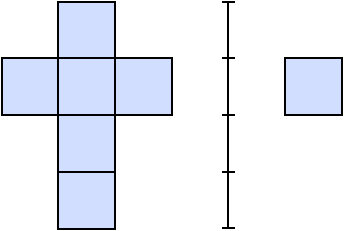|
A planar cross
We might compare the Dali cross with a more orthodox cross, the plane face of which comprises six adjoining squares.
Notice that we would in fact obtain this plane figure by looking at the Dali cross ‘straight on’. This shape is the standard net for constructing a cube. If we now looked at this planar cross ‘edge on’ we would see four adjoining line segments. These can be thought of as a ‘net’ for a square.
The process appears to end here, for if we look at the four collinear line segments end on, we see a single point! However, the idea of dimension is clearly present. Perhaps we might get more insight by considering the constructed figures (cube, square), rather than the nets.
 Investigate Carefully draw your own 6-square cross on light cardboard. Add a small flap to every second outside edge. Cut out your shape, with flaps, and carefully fold along remaining lines. Assemble your resulting net to form a cube. Investigate Carefully draw your own 6-square cross on light cardboard. Add a small flap to every second outside edge. Cut out your shape, with flaps, and carefully fold along remaining lines. Assemble your resulting net to form a cube.
 Project Find out about model-making. Construct your own collection of models. For example, there are five regular and 13 semi-regular polyhedra. Project Find out about model-making. Construct your own collection of models. For example, there are five regular and 13 semi-regular polyhedra.
|